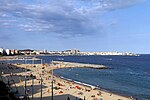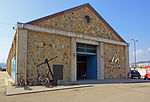The Maritime Rescue Museum
Buildings and structures completed in 1890Maritime museums in CataloniaMuseums in Baix EmpordàMuseums with year of establishment missing

The Maritime Rescue Museum is an old rescue shipwreck station located in the port of Sant Feliu de Guíxols, in the Baix Empordà region of Spain. It was built in the 19th century and it is protected as a Bé Cultural d'Interès Local, a cultural asset of local interest. As of 2017, it is a branch of the Museum of History of Sant Feliu de Guíxols, dedicated to marine rescue.
Excerpt from the Wikipedia article The Maritime Rescue Museum (License: CC BY-SA 3.0, Authors, Images).The Maritime Rescue Museum
Passeig del Fortim,
Geographical coordinates (GPS) Address External links Nearby Places Show on map
Geographical coordinates (GPS)
| Latitude | Longitude |
|---|---|
| N 41.77997 ° | E 3.03544 ° |
Address
Museu del Salvament Marítim
Passeig del Fortim
17220
Spain
Open on Google Maps








